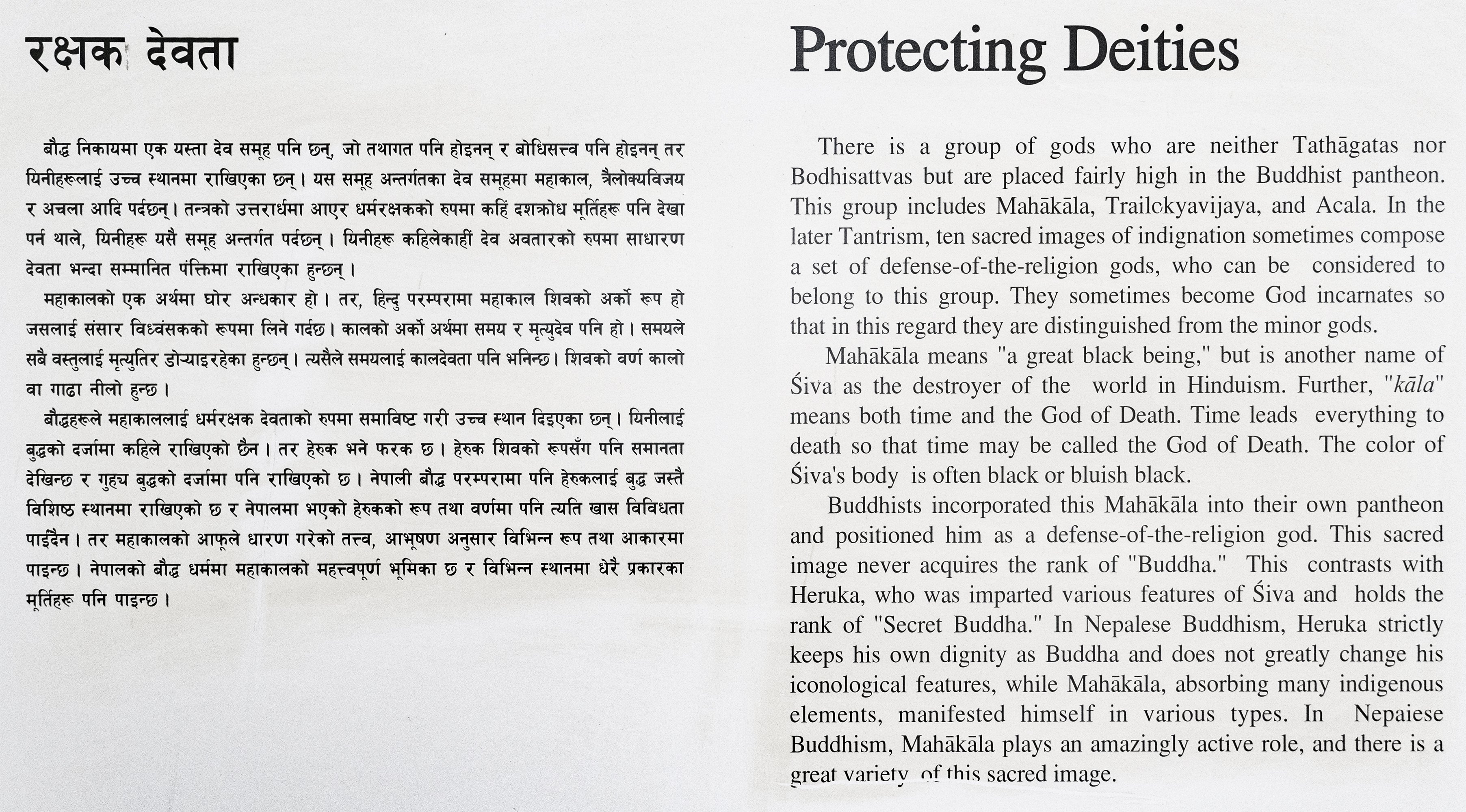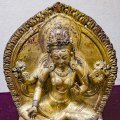Buddhist Art Gallery: Northern Himalayan Section: photo 165
Photo 165 of 198 in Gallery: Buddhist Art Gallery: Northern Himalayan Section

Image title: Protecting Deities (Rakshaka Devata)
Description of the photo
English text:
There is a group of gods who are neither Tathagatas nor Bodhisattvas but are placed fairly high in the Buddhist pantheon. This group includes Mahakala, Trailokyavijaya, and Acala. In the later Tantrism, ten sacred images of indignation sometimes compose a set of defense-of-the-religion gods, who can be considered to belong to this group. They sometimes become God incarnates so that in this regard they are distinguished from the minor gods.
Mahakala means “a great black being,” but is another name of Śiva as the destroyer of the world in Hinduism. Further, “kala” means both time and the God of Death. Time leads everything to death so that time may be called the God of Death. The color of Śiva's body is often black or bluish black.
Buddhists incorporated this Mahakala into their own pantheon and positioned him as a defense-of-the-religion god. This sacred image never acquires the rank of “Buddha.” This contrasts with Heruka, who was imparted various features of Siva and holds the rank of “Secret Buddha.” In Nepalese Buddhism, Heruka strictly keeps his own dignity as Buddha and does not greatly change his iconological features, while Mahakala, absorbing many indigenous elements, manifested himself in various types. In Nepaiese Buddhism, Mahakala plays an amazingly active role, and there is a great variety of this sacred image.
Nepalese text (not proofread)
रक्षक देवता—बौद्ध निकायमा एक यस्ता देव समूह पनि छन्, जो तथागत पनि होइनन् र बोधिसत्त्व पनि होइनन् तर यिनीहरूलाई उच्च स्थानमा राखिएका छन् । यस समूह अन्तर्गतका देव समूहमा महाकाल, त्रैलोक्यविजय र अचला आदि पर्दछन् । तन्त्रको उत्तरार्धमा आएर धर्मरक्षकको रुपमा कहिं दशक्रोध मूर्तिहरू पनि देखा पर्न थाले, यिनीहरू यसै समूह अन्तर्गत पर्दछन् । यिनीहरू कहिलेकाहीं देव अवतारको रुपमा साधारण देवता भन्दा सम्मानित पंक्तिमा राखिएका हुन्छन् ।
महाकालको एक अर्थमा घोर अन्धकार हो । तर, हिन्दु परम्परामा महाकाल शिवको अर्को रूप हो जसलाई संसार विध्वंसकको रूपमा लिने गर्दछ । कालको अर्को अर्थमा समय र मृत्युदेव पनि हो । समयले सबै वस्तुलाई मृत्युतिर डोर्याइरहेका हुन्छन् । त्यसैले समयलाई कालदेवता पनि भनिन्छ । शिवको वर्ण कालो वा गाढा नीलो हुन्छ ।
बौद्धहरूले महाकाललाई धर्मरक्षक देवताको रुपमा समाविष्ट गरी उच्च स्थान दिइएका छन् । यिनीलाई बुद्धको दर्जामा कहिले राखिएको छैन । तर हेरुक भने फरक छ । हेरुक शिवको रूपसँग पनि समानता देखिन्छ र गुह्य बुद्धको दर्जामा पनि राखिएको छ । नेपाली बौद्ध परम्परामा पनि हेरुकलाई बुद्ध जस्तै विशिष्ठ स्थानमा राखिएको छ र नेपालमा भएको हेरुकको रूप तथा वर्णमा पनि त्यति खास विविधता पाईंदैन । तर महाकालको आफूले धारण गरेको तत्त्व, आभूषण अनुसार विभिन्न रूप तथा आकारमा पाइन्छ । नेपालको बौद्ध धर्ममा महाकालको महत्त्वपूर्ण भूमिका छ र विभिन्न स्थानमा धेरै प्रकारका मूर्तिहरू पनि पाइन्छ ।
Nepalese to English (automated translation)
Guardian Deities—There is also a group of deities in the Buddhist body, who are neither Tathagatas nor Bodhisattvas, but they are placed in a high position. The deities under this group include Mahakala, Trailokyavijaya and Achala etc. In the second half of the Tantra period, some Dakrodha idols also started to appear as guardians of religion, they belong to this group. They are sometimes placed in a higher rank than ordinary deities as god avatars.
In one sense, Mahakala is a deep darkness. However, in the Hindu tradition, Mahakala is another form of Shiva who is considered as the destroyer of the world. Kaal is also the god of time and death in another sense. Time leads all things to death. That is why time is also called Kaldevata. Shiva's color is black or dark blue.
Buddhists have included Mahakala as the guardian deity and given a high position. He has never been placed in the rank of Buddha. But Heruk is different. Heruk also looks similar to the form of Shiva and is also placed in the status of Guhya Buddha. Even in Nepali Buddhist tradition, Heruk is placed in a special place like Buddha and there is not so much variety in the form and color of Heruk in Nepal. But according to the elements and ornaments worn by Mahakal, they are found in different forms and shapes. Mahakala has an important role in Buddhism in Nepal and many types of idols are also found in different places.
Transcription (with diacritics):
Rakṣaka devatā—bauddha nikāyamā eka yastā deva samūha pani chan, jo tathāgata pani hoinan ra bodhisattva pani hoinan tara yinīharūlāī ucca sthānamā rākhiekā chan . Yasa samūha antargatakā deva samūhamā mahākāla, trailokyavijaya ra acalā ādi pardachan . Tantrako uttarārdhamā āera dharmarakṣakako rupamā kahiṃ daśakrodha mūrtiharū pani dekhā parna thāle, yinīharū yasai samūha antargata pardachan . Yinīharū kahilekāhīṃ deva avatārako rupamā sādhāraṇa devatā bhandā sammānita paṃktimā rākhiekā hunchan .
mahākālako eka arthamā ghora andhakāra ho . Tara, hindu paramparāmā mahākāla śivako arko rūpa ho jasalāī saṃsāra vidhvaṃsakako rūpamā line gardacha . Kālako arko arthamā samaya ra mṛtyudeva pani ho . Samayale sabai vastulāī mṛtyutira ḍoryāirahekā hunchan . Tyasaile samayalāī kāladevatā pani bhanincha . Śivako varṇa kālo vā gāḍhā nīlo huncha .
bauddhaharūle mahākālalāī dharmarakṣaka devatāko rupamā samāviṣṭa garī ucca sthāna diiekā chan . Yinīlāī buddhako darjāmā kahile rākhieko chaina . Tara heruka bhane pharaka cha . Heruka śivako rūpasaṃga pani samānatā dekhincha ra guhya buddhako darjāmā pani rākhieko cha . Nepālī bauddha paramparāmā pani herukalāī buddha jastai viśiṣṭha sthānamā rākhieko cha ra nepālamā bhaeko herukako rūpa tathā varṇamā pani tyati khāsa vividhatā pāīṃdaina . Tara mahākālako āphūle dhāraṇa gareko tattva, ābhūṣaṇa anusāra vibhinna rūpa tathā ākāramā pāincha . Nepālako bauddha dharmamā mahākālako mahattvapūrṇa bhūmikā cha ra vibhinna sthānamā dherai prakārakā mūrtiharū pani pāincha .
Transcription (without diacritics):
rakshaka devata—bauddha nikayama eka yasta deva samuha pani chan, jo tathagata pani hoinan ra bodhisattva pani hoinan tara yiniharulai ucca sthanama rakhieka chan . yasa samuha antargataka deva samuhama mahakala, trailokyavijaya ra acala adi pardachan . tantrako uttarardhama aera dharmarakshakako rupama kahim dashakrodha murtiharu pani dekha parna thale, yiniharu yasai samuha antargata pardachan . yiniharu kahilekahim deva avatarako rupama sadharana devata bhanda sammanita pamktima rakhieka hunchan .
mahakalako eka arthama ghora andhakara ho . tara, hindu paramparama mahakala shivako arko rupa ho jasalai samsara vidhvamsakako rupama line gardacha . kalako arko arthama samaya ra mrityudeva pani ho . samayale sabai vastulai mrityutira doryairaheka hunchan . tyasaile samayalai kaladevata pani bhanincha . shivako varna kalo va gadha nilo huncha .
bauddhaharule mahakalalai dharmarakshaka devatako rupama samavishta gari ucca sthana diieka chan . yinilai buddhako darjama kahile rakhieko chaina . tara heruka bhane pharaka cha . heruka shivako rupasamga pani samanata dekhincha ra guhya buddhako darjama pani rakhieko cha . nepali bauddha paramparama pani herukalai buddha jastai vishishtha sthanama rakhieko cha ra nepalama bhaeko herukako rupa tatha varnama pani tyati khasa vividhata paimdaina . tara mahakalako aphule dharana gareko tattva, abhushana anusara vibhinna rupa tatha akarama paincha . nepalako bauddha dharmama mahakalako mahattvapurna bhumika cha ra vibhinna sthanama dherai prakaraka murtiharu pani paincha .
Gallery information:
The Northern Himalayan region in Nepal offers a wide variety of Buddhist objects such as paintings, scriptures, sculptures, ritualistic objects, etc. Buddhism once entered Tibet from Nepal and has blended in its own way there, resulting in Tibetan Buddhism which is divided into many schools. The items found here are exhibited in the National Museum of Nepal (Rashtriya Museum).
Photo details:
Date: 2019-12-04
Camera: SONY ILCE-6400
Exposure: 1/160
Aperture: f/4
ISO: 800
Focal length: 26mm
High resolution:
Download file
Size: 4.66 MB
Resolution: 3609 x 2000
© Photograph by Gabe Hiemstra.
License: CC BY-NC-ND 4.0

